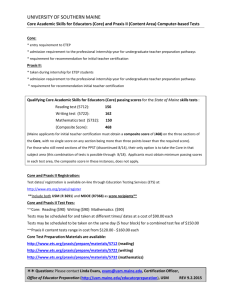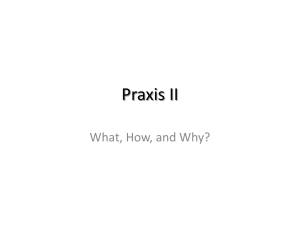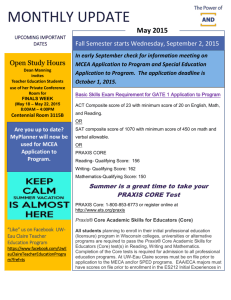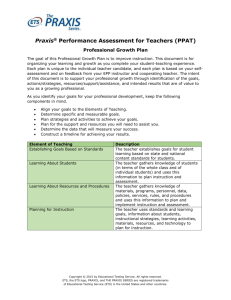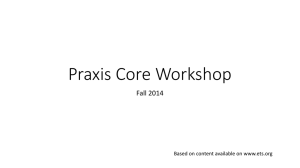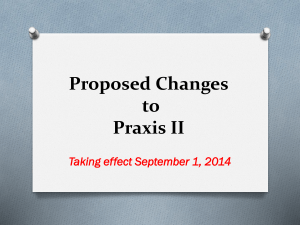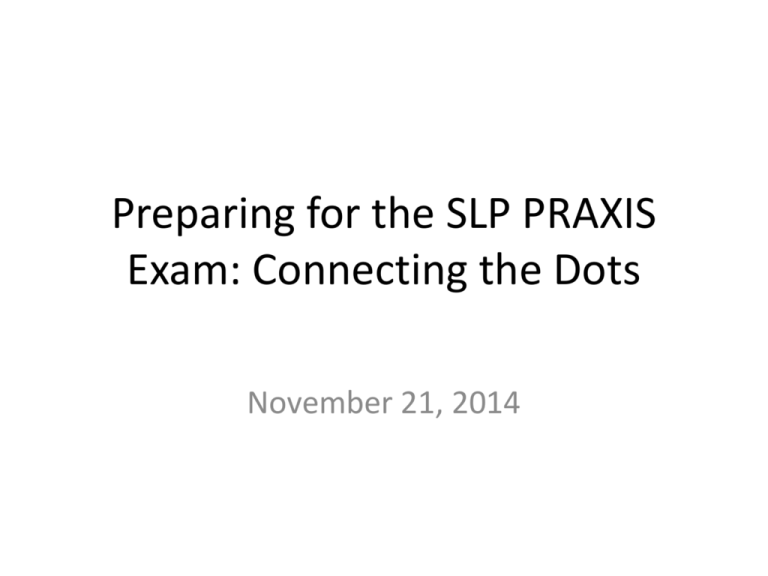
Preparing for the SLP PRAXIS
Exam: Connecting the Dots
November 21, 2014
Overview
•
•
•
•
•
•
Test at a Glance – Melissa Passe
Clinical Management – Melissa Passe
Dysphagia – Ken Logan
Child Language – Diane Paul
School-Based Issues – Deborah Dixon
Praxis Overview – Kathy Pruner
Test at a Glance
SLP 5331 Study Companion
• Provides test blueprint
(TAAG)
• Sample questions with
answers and rationales
• General information
and study tips
• Study plan document
TAAG for New Test - SLP (5331)
Changes to the categories
and proportions
SLP TAAG
Copyright© 2014 by
Educational Testing Service. All
rights reserved. ETS, the ETS
logo, LISTENING. LEARNING.
LEADING., PRAXIS
and THE PRAXIS SERIES are
Important information about
test purpose and use
What’s Changed with the SLP Test?
Speech-Language Pathology 5331
Speech-Language Pathology 0330/5330
Number of questions
132 selected-response questions
120 multiple-choice questions
Time allotted
150 minutes
120 minutes
Multiple choice items
4 answer options
5 answer options
Content categories
I.
I.
Score scale range and
score intervals
Study Companion practice
questions
100 – 200 in 1-point intervals
Basic Human Communication
Processes
II. Phonological and Language
Disorders
III. Speech Disorders
IV. Neurogenic Disorders
V. Audiology/Hearing
VI. Clinical Management
VII. Professional
Issues/Psychometrics/Research
250 – 990 in 10-point intervals
32 sample questions with answers
and rationales are provided
24 sample questions with answers and
rationales are provided
Foundations and Professional
Practice
II. Screening, Assessment,
Evaluation and Diagnosis
III. Planning, Implementation, and
Evaluation of Treatment
The Big 9
1.
2.
3.
4.
5.
6.
7.
8.
9.
Foundations
Professional Practice
Screening
Approaches to Assessment and Evaluation
Assessment Procedures and Assessment
Etiology
Treatment Planning
Treatment Evaluation
Treatment
Clinical Management
Clinical Management Case Study
A 5-year-old female, Abby, is brought in to you by
her parents for a speech evaluation. It is reported
by the parents that Abby talks all the time but is
very difficult for her friends and neighbors to
understand. Abby is an only child and has met all of
her developmental milestones. Upon informally
assessing Abby in structured play you determine
that she is 50% unintelligible. English is the only
language spoken in the home. Abby is friendly and
outgoing and not afraid to verbally engage with you
while she is in your office.
Clinical Management Question 1
Which of the following evaluation measures
should you include right away?
a. An oral mechanism examination and hearing
screening
b. A videostrobe of her larynx and PPVT
c. An articulation and/or phonological exam
d. Answers A and C
Clinical Management Question 2
As you are assessing Abby you learn that several
sounds are consistently misarticulated. She often
produces t/k. You need to know if Abby can
produce /k/ in isolation. You model placement and
production of /k/ and then ask her to imitate your
model. This is an example of assessing Abby’s
a. diadochokinetic skills
b. receptive phonology skills
c. general phonological knowledge
d. stimulability
Clinical Management Question 3
You determine that Abby uses a number of
phonological processes. One of the frequently
occurring processes is stopping. You know this
when you hear Abby produce
a. ruz/rush
b. nake/snake
c. tu/shoe
d. bae/bath
Clinical Management Question 4
One of the approaches you could employ in
treatment with Abby is the use of distinctive
features. When using this you would
a. use auditory bombardment as a permanent
component of each intervention
b. determine Abby’s underlying patterns and train
several sounds within those patterns so that
generalization to other surrounding sounds
would occur
c. use minimal pairs
d. answers B & C
Professional Issues Questions
According to ASHA standards, which of the following
activities would NOT be within the scope of practice for a
speech-language pathologist?
a. Using instruments such as stroboscopy, video
fluoroscopy, and nasendoscopy
b. Fitting and prescribing hearing aids for your aural
rehab patient (Key—hearing aid distribution and
fitting is not within the ASHA scope for the SLP)
c. Assessing and treating swallowing and upper
aerodigestive disorders in infant feeding
d. Prescribing AAC devices and systems
Professional Issues Question 2
You are about to begin your CF experience. You have
found a CF mentor and are ready to begin your
employment. Your mentor works in the same building
that you do and plans to observe you quite often face to
face. You must first:
a. Submit a plan in writing to the CFCC to approve your
employment setting
b. Check the certification status of your mentor and
ensure he/she is in good standing
c. Make sure your CF mentor has supervised at least 5
other CF individuals before you
d. Pay the CF mentor yourself to supervise you
Dysphagia Case Study
Dysphagia Case Study
Patient is a 71-year-old female admitted yesterday
with a right side pontine stroke that has destroyed
all pontine motor and sensory nuclei. The patient
failed the bedside nursing swallowing screen. Her
prior medical history includes chronic obstructive
pulmonary disease. Five years earlier she
underwent an aortic valve replacement under
routine, uncomplicated endotracheal intubation
and immediate post-operative extubation, after
which she awoke with breathy dysphonia. She was
found to have a paralyzed vocal fold and the next
year underwent a thyroplasty.
Dysphagia Question 1
Which of the following impairments would be directly
associated with the pontine stroke? Choose all that
are correct.
a) Weakness in right mandible elevation and depression
causing impaired mastication.
b) Weakness in hyolaryngeal excursion on the right side
causing impaired opening of the upper esophageal
sphincter during the pharyngeal swallow.
c) Loss of all tactile (touch, pain, temperature, pressure)
sensation in the right oral cavity anterior to the soft
palate.
d) Loss of all left sided oral tactile (touch, pain,
temperature, pressure) sensation in the left oral cavity
anterior to the soft palate, and loss of left sided
mandible elevation.
Dysphagia Question 2
Which of the following is the most likely scenario explaining
the prior history of postoperative dysphonia and vocal fold
paralysis?
a. The right vocal fold was paralyzed because of traumatic
endotracheal intubation during surgery.
b. The right vocal fold was paralyzed because right recurrent
laryngeal nerve courses under the arch of the aorta before
ascending to innervate the right larynx and muscles that
move the right vocal folds.
c. The left vocal fold was paralyzed because the left recurrent
laryngeal nerve courses under the arch of the aorta before
ascending to innervate the left larynx and muscles that
move the left vocal folds.
d. The left vocal fold was paralyzed because it is innervated by
cranial nerves that originate in right pontine motor nuclei.
Dysphagia Question 3
According to the literature regarding swallow-respiratory
coordination in healthy persons, patients with chronic
obstructive pulmonary disease (COPD) and patients with
stroke, which of the following statements is true? Choose all
that are correct.
a. Healthy adults tend to exhale after swallowing while
patients with COPD tend to inhale after swallowing
b. Post-swallow exhalation occurs with the same frequency
in patients with COPD as occurs in healthy persons.
c. Post-swallow exhalation occurs with significantly lower
frequency in patients with COPD than occurs in healthy
persons.
d. Post-swallow exhalation occurs with significantly lower
frequency in patients with stroke than occurs in healthy
persons.
Dysphagia Question 4
Which of the following statements about oral
endotracheal intubation in this case is true? Choose all
that are correct.
a. This patient was intubated for a “prolonged
duration.”
b. Endotracheal intubation can cause mucosal trauma
to the inside of the larynx including the vocal folds.
c. Endotracheal intubation is a common cause of
vocal fold paralysis.
d. For the described surgery, the patient had a
tracheostomy tube that was inserted through a
surgically created incision on the anterior neck.
Child Language Case Study
Child Language Case Study
Louis and Casey seek an evaluation for their 4year-old daughter, Lena. Her preschool teacher
says that Lena doesn’t play or talk much to
children or adults. She rarely looks at the
parents when she talks and she ignores
questions. She doesn’t say what she wants. She
doesn’t take turns or start conversations. The
SLP conducts a comprehensive evaluation,
which confirms these communication behaviors.
Child Language Case Study
In addition to the communication behaviors
described, the assessment reveals that
1. Most familiar and unfamiliar listeners
understand Lena’s speech, but she
mispronounces the /r/ and /s/ sounds.
2. Lena uses four- to five-word utterances, but has
mistakes like “I goed home.”
3. Lena comprehends most of what is said at home
and at school.
4. Lena does not display repetitive patterns of
behavior.
Child Language Question 1
What is the most likely diagnosis or conclusion
based on these communication, speech, and
language findings?
a. Autism spectrum disorder
b. Social (pragmatic) communication disorder
c. Specific language impairment with a mild
speech-sound production disorder
d. Typical development across domains
Child Language Case Study
Jeremy is a 2-year-old boy. His parents are
concerned because he is not talking. Jeremy’s
pediatrician told the parents that he will outgrow
the problem. They said that all children develop at a
different pace and they shouldn’t be concerned.
The SLP evaluates Jeremy as part of an early
intervention team. The team finds that Jeremy’s
hearing is normal and he has no other
developmental delays. Jeremy typically uses sounds
and gestures to communicate. He responds to his
own name and follows simple directions. He has
about 10 single words, but they are not intelligible.
Child Language Question 2
Based on this assessment information, the SLP decides to
provide the parents with a list of language stimulation
exercises? What else would be SLP be likely to recommend?
a. Suggest that the parents monitor speech and language
development for 6 months. Indicate that Jeremy is likely a
late talking child who will catch up soon.
b. Start an early intervention program focused primarily on
expressive language.
c. Start an early intervention program focused primarily on
receptive language.
d. Start an early intervention program focused primarily on
speech sound production.
Child Language Case Study
Parents have come to an SLP with concerns about
their 4-year-old child’s reading and writing ability.
Lyndsay can point to and name pictures in a book.
She likes having books read to her. She can turn
pages one at a time. She doesn’t say rhyming words
and doesn’t realize that words can be broken into
smaller segments. She doesn’t know printed letters
in the alphabet and doesn’t realize that letters have
sounds. Receptive and expressive language skills are
consistent with typical development.
Child Language Question 3
What would be the likely course of action for the SLP?
a. Advise the parents that Lyndsay is proceeding according
to typical development for written language; suggest
that they continue to read to her.
b. Indicate that reading skills are emerging but appear to
be at a 2- to 3-year level. Start an SLP treatment
program focused on word recognition and using words
in a story.
c. Indicate that reading skills are approximately 2 years
delayed. Start an SLP treatment program focused on
learning sound-letter correspondence.
d. Conduct an evaluation of speech sound development.
School-Based Questions
Schools
A referral is sent to the school’s SLP, because a student is
having difficulty learning new vocabulary, summarizing
what he’s read, and participating in classroom
discussions.
What would be the most appropriate response to this
referral?
A. Provide direct service within Response to Intervention
model for the student.
B. Contact the family, requesting permission to conduct
a full evaluation.
C. Conduct a screening with the student.
D. Refer the student to the reading specialist.
Schools
If the student is found to be a in need of an evaluation,
what must be included in the Evaluation Report? (Choose
all correct answers.)
A. Summary of input from the family and classroom
teachers.
B. Information about all areas of the child’s functioning
(e.g., communication, intelligence, motor abilities).
C. Only information regarding the child’s academic and
communication skills.
D. Recommendations regarding eligibility for special
education.
Schools
If this student’s primary language is not English,
which is the best way to administer the tests?
A. Using only assessments normed for the
student’s native language.
B. Using the language the child commonly uses.
C. First administering in English, then in the
student’s native language.
D. Using a family member to interpret the tests.
Schools
Which of the following must be followed in the
school setting (choose all correct answers)
A. Family Educational Rights and Privacy Act
(FERPA)
B. Individuals with Disabilities Education
Improvement Act of 2004 (IDEA 2004)
C. Section 504 of the Rehabilitation Act of 1973
D. Americans with Disabilities Reauthorization Act
of 2009
Praxis® SLP Test Update
Background on ETS
• Non-profit organization, founded in 1947; combined ACE,
Carnegie Foundation and College Entrance Examination Board
• Mission: Advance quality and equity in education for all people
worldwide
• ETS develops, administers, and scores
– 50+ million assessments in
– 180 countries at over
– 9,000 locations worldwide
Copyright© 2014 by Educational Testing Service. All rights reserved. ETS, the ETS logo,
LISTENING. LEARNING. LEADING., PRAXIS and THE PRAXIS SERIES are registered
trademarks of Educational Testing Service (ETS).
37
How are ASHA’s Praxis Exams Developed?
[1]
Practice
Analysis
[7]
Passing
Score
Determined
[6]
Standard
Setting
[2]
Test
Blueprint
Test
Development/
Regeneration
Process
[5]
Validity
[4]
Equating
Set
[3]
Item
Writing
2014-2015 Testing Schedule
Computer Testing Windows:
SLP available every month
• 12/8/14 – 12/20/14
• 1/12/15 – 1/24/15
• 2/9/15 – 2/21/15
• 3/9/15 – 3/21/15
•
•
•
•
•
4/6/15 – 4/17/15
5/11/15 – 5/22/15
6/15/15 – 6/26/15
7/13/15 – 7/25/15
8/10/15 – 8/22/15
With computer tests, students can register up to 3 days
before test day and not pay a late fee.
Copyright© 2011 Educational Testing Service. All rights reserved. ETS, the ETS logo and LISENTING. LEARNING. LEADING.
are registered trademarks of Educational Testing Service (ETS). THE PRAXIS SERIES is a trademark of ETS.
Test Prep Materials for
The Praxis® SLP Exam
Copyright © 2011 by Educational Testing Service. All rights reserved. ETS, the ETS logo and LISTENING. LEARNING. LEADING., PRAXIS I, PRAXIS II and SCORELINK are
registered trademarks of Educational Testing Service (ETS). PRAXIS and THE PRAXIS SERIES are trademarks of ETS. 17025
Free Test Prep
• Comprehensive Praxis Study Companion
– Test at a Glance (TAAG)
– Study Plan document
– Sample questions with answers and rationales
• Prerecorded Webinars: on demand webinar videos
– Assists those who are not able to attend live
webinars due to class, work, or time zone conflicts
• Live one-hour webinars: all start at 1:00 P.M. ET
– Tuesday, January 27, 2015
41
Sample Study Plan Using Study
Companion
Content
covered
Description
of content
How well do I
know the
What resources Where can I find
content?
do I have/need the resources I
(scale 1–5) for this content?
need?
Content based
on TAAG
Dates I will
study this
content
Test taker fills in grid
to develop study plan
Copyright© 2011 Educational Testing Service. All rights reserved. ETS, the ETS logo and LISENTING.
LEARNING. LEADING.
are registered trademarks of Educational Testing Service (ETS). THE PRAXIS SERIES is a trademark of
Date
completed
“Strategies for Success” Video
www.ets.org/praxis/strategiesforsuccess
43
“What to Expect on Testing Day” Video
www.ets.org/praxis/testday
44
Updated Computerized Testing Experience Video
www.ets.org/praxis/computertestingdemo
45
Interactive Practice Tests
• Detailed explanations for correct answers to the
practice questions
• Content category scores indicating the number of
questions answered correctly in each content
category to help you understand your performance
level
• Real test directions and questions similar to those
you will see on test day
• A timer that to simulate the actual test experience
• $17.95 for 10 uses or 90 days
• SLP Interactive Practice Test - available Jan. 2105
46
Interactive Practice Test
47
Test Prep Discount Offer
Save 10% on Praxis Test Preparation
1. Visit www.ets.org/praxis/store
2. Enter Promo Code: CRDKP for each
resource you order
Note: promo code is not case sensitive
Praxis Score Reports:
Reviewing Your Performance
Your Score
• Score scale is now 100-200 in 1 point
intervals
• ASHA requires a 162 to pass test
• Unofficial score results viewed immediately
at test center
• Official score reports available online 10-12
business days after the window closes
• Scores are available online for 1 year for you
to download
• Additional score reports - $40
50
Score Reporting
• Send your scores to your attending institution
• Unofficial score results viewed immediately at
test center
• Official score reports available online 10-12
business days after the window closes
• Scores are available online for 1 year for you
to download
• Additional score reports - $40
51
Copyright © 2011 by Educational Testing Service. All
rights reserved. ETS, the ETS logo and LISTENING.
LEARNING. LEADING., PRAXIS I, PRAXIS II and
SCORELINK are registered trademarks of Educational
Testing Service (ETS). PRAXIS and THE PRAXIS SERIES
are trademarks of ETS. 17025
Category Performance
Copyright © 2011 by Educational Testing Service. All rights reserved. ETS,
the ETS logo and LISTENING. LEARNING. LEADING., PRAXIS I, PRAXIS II and
SCORELINK are registered trademarks of Educational Testing Service (ETS).
PRAXIS and THE PRAXIS SERIES are trademarks of ETS. 17025
Recent Enhancements
• You now get 4 free score reports instead of 3 — a
savings of $40
– Note that many state education departments
automatically receive your scores if you test in that state.
• Registration is simplified – you now choose
agency/ASHA (or state) for listing of required test
(rather than searching by test name or from the
entire list) – cutting down wrong choices
• You will receive e-mail notification when scores are
ready
• Access through your Praxis account and print copy
for your records
54
Test-Taking Strategies
• Don’t leave any questions blank since your score is
based on the number of questions you answer
correctly with no penalty for an incorrect answer
• If you don’t know the answer, try to eliminate obvious wrong
answers and guess the correct one
• Pace yourself and allow ample time per question
• You can answer questions in any order
– You can mark harder questions for “Review” using a review
button and come back to them by viewing the review page
– Practice these features at
www.ets.org/praxis/computertestingdemo
• Read all possible answers before picking one
• Review your answers if you have time at the end
• You just need a passing score
Smart Tips
• Don’t sell your textbooks from
• Scan the answer choices before
introductory classes as they can be
you start reading the material
an important source of study
and/or working the problem.
material.
• In multiple-choice items, you
• Don’t worry about your score when
need to choose the correct
taking the test.
answer, but you do not need to
• Keep track of time.
prove it. Don’t waste your time
• Do not take too much time on any
trying to prove the answer.
one question.
• Be well-rested on test day.
• Be aware of key words such as
NOT, BEST, LEAST, EXCEPT …
Copyright © 2012 Educational Testing Service. All rights reserved.
Test Taker Support
General Inquiries:
Phone: 800-772-9476 (U.S., U.S. Territories,
and Canada) or at 609-771-7395 (for all
other locations)
E-mail: praxis@ets.org
Hours: Mon – Fri 8:00 A.M. 7:45 PM EST
Copyright© 2014 Educational Testing Service. All rights reserved. ETS, the ETS logo and LISENTING. LEARNING. LEADING. and Praxis
are registered trademarks of Educational Testing Service (ETS). THE PRAXIS SERIES is a trademark of ETS.
THANK YOU!
www.asha.org/certification/
www.ets.org/praxis


